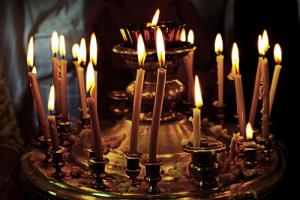There is an ancient connection between man and fire. Every man should know how to start a fire. A real man knows how to do this without using matches. This is an important skill that can help you survive. You never know when you'll be faced with the need to start a fire and don't have any matches with you. For example, your plane may crash somewhere in the deep forests. Or you'll go camping and lose your backpack during a fight with a bear. But everything can be much more prosaic - even windy or damp weather can make matches completely useless. And it doesn’t matter at all whether this skill is useful to you, it’s so great to learn how to light a fire wherever and whenever you find yourself.
1. Making fire by friction
This activity is not for the faint of heart. And perhaps the most difficult. Exist different techniques friction, but the deciding factor in any technique is the type of wood you use for the board and rod.
A rod is a stick that is used to rotate and create friction. If, by rotating the rod, you create enough friction between it and the plank that the latter begins to smolder, then you can light a fire. The board is best made from poplar, juniper, aspen, willow, cedar, cypress or walnut wood.
Dry wood should be used for ignition.
Gimlet/hand drill
This is the most primitive method, primitive and very complex. All you need is wood, hands and unwavering determination.
- Build a nest from tinder. You will need to pour the coals that appear from friction into this nest. The nest can be made from anything that burns easily: dry grass, leaves and bark.
- Make a funnel. Make a funnel in the fire board into which the rod will then be inserted; under the funnel you can make a cavity for tinder.
- Place the bark under the funnel. Smoldering embers should be placed on the bark, which are formed due to the friction of the rod against wooden board.
- Start rotating the rod. Place the rod into the funnel on your board. The rod should be about 60 cm long. Press down on the board and begin to rotate the rod, holding it between your palms. Move your palms in quick rotating movements along the entire length of the shaft. Continue until smoke appears.
- Light a fire. When you notice smoke, tap the board so that the embers that appear fall on the bark. Transfer the bark to the nest.
2. Fire plow
- Cut a groove in the board. It will serve as a path for the rod.
- Rub. Place the end of the rod into the groove. Begin to move the end of the rod along the groove with pressure.
- Light a fire. Place a nest of tinder at one end of the board, and lift the board itself during friction so that the coals fall there.
3. Bow drill
This is perhaps the most effective method starting a fire. It allows you to achieve the desired speed and pressure necessary for the appearance of embers and smoldering much faster and, accordingly, make the fire faster. In addition to the rod and plank, you will need a block and a bow.
- Find the block. It will be needed to create additional pressure on the rod, which you will rotate with the bow. You can use a stone or another piece of wood as a block. For a wooden block, try to find wood that is larger hard rocks than the one from which the rod will be made.
- Make a bow. The bow should be approximately arm length. To create it, use a flexible, slightly curved rod. It should be strong enough. Pull the string onto the rod and you're done.
- Prepare a fire board. Make a funnel and a cavity underneath for the tinder. Place the tinder directly under the funnel.
- Place the string on the shaft. Fold the string to form a loop and thread the rod through it. Place one end of the rod on a wooden board, and press the other end with a block.
- Start sawing. Using the bow, begin to quickly move it back and forth as if you were sawing. We can say that you have created a primitive mechanical drill. The rod must be rotated quickly. Continue sawing until embers appear.
- Light a fire. Drop the embers into the tinder nest and blow gently.
4. Flint (chair, flint, tinder)
This is an ancient technique. It never hurts to take a flint with you when going on a hike. Matches may become wet and unusable, but you can still get a spark using a flint and wood block.
If you don't have a flint with you, you can easily make one yourself, for this you will need quartzite and the steel blade of your folding knife. You carry a folding knife with you, don't you? In addition, you will need charcoal. Sparks will fall on the coal and it will smolder. If you don't have coal, use birch bark or tinder.
- Take flint and coal. Clamp the flint between the large and index fingers. The tip of the flint should protrude 5-7 cm. Hold the coal between your thumb and the flint.
- Hit. Use the back of a knife blade. Hit the stone with it several times. The sparks from the impact should hit the charcoal, which in turn will begin to smolder.
- Light a fire. Place the coal in the tinder nest and blow gently.
5. Lenses
This is one of the most simple ways making fire. Any boy who has ever melted plastic soldiers knows how it works. If you've never melted your toy soldiers, then read on.
Regular lenses
To start a fire, you need lenses to pass through sunlight. A magnifying glass, glasses or binoculars - anything will do. If the lens is moistened with water, the process of making fire will speed up. Position the lens at an angle so that sunlight hits it and the beam is focused in one place. Place a nest of tinder in the place where the beam falls, and very soon you will make yourself a fire.
The only drawback of this method is that it only works in sunny weather.
In addition to regular lenses, you can use some other items to make fire using this method.
Balls and condoms
Filling a balloon or condom with water turns it into a lens.
Pour water into a balloon or condom and tie it. At the same time, they should take on the shape of a sphere (as far as possible). Don't make them very large or you will have difficulty focusing the sunlight. Squeeze the ball so that it gives you a clear circle of light. Try squeezing the condom in the middle so that it forms 2 lenses of smaller diameter.
Balls and condoms should be kept about 5cm away from the tinder as their focal length is much shorter than lenses.
6. Fire from ice
The phrase sounds like one of those school essay topics, but in fact, ice can help you light a fire. All you need to do is make a lens out of a piece of ice and use it like a regular lens.
- Use clean water. The ice should be transparent. If it is cloudy or has specks in it, you won't succeed. To get clear ice, pour water from a lake, pond, or simply put snow in a mug or some container. Let the liquid freeze. For this method to work, the piece of ice must be about 5 cm thick.
- Make a lens. Use a knife to cut a lens out of ice. Remember that the lens is usually thicker in the center than at the edges.
- Polish the lens. After shaping it, polish the lens with your hands. The warmth of your hands will melt the ice a little and make its surface smooth.
- Light a fire. Point the lens towards sunlight. Focus the beam on the tinder and wait for the fire to appear.
7. Aluminum can and chocolate bar
- Polish the bottom of the jar with chocolate. Just move the chocolate along the bottom of the jar. Then wipe the bottom clean with a piece of cloth. Chocolate - excellent remedy for a polish that will make the bottom of the jar shine like a mirror. If you don't have chocolate with you, toothpaste will do too. Repeat this several times.
- Light a fire. By polishing the bottom of the jar, you get a mirror. The sun's rays will reflect off the bottom and create a focal point. The operating principle is the same as in a telescope. Turn the bottom of the jar towards the sun. The rays, as in other cases with lenses, should be directed at the tinder. Place the tinder 2-3 cm from the focal point. The flame will appear in a few seconds.
Although it is very difficult to imagine how you could find yourself in the middle of nowhere with an aluminum can and a bar of chocolate, this method of making fire is simply wonderful.
8. Batteries and steel wool
As with the jar and the chocolate, it's hard to imagine not having matches, but having batteries and steel wool. But nothing can be known for sure. In the end, just for fun, you can do this at home.
- Pull out the fur. It is necessary to obtain a strip about 15 cm long and 1-2 cm wide.
- Rub the battery on the wool. Take the wool in one hand and the battery in the other. Any battery will do for this job, but it is best to use a 9-volt one. Rub the contact side of the battery on the wool. The latter will begin to smoke and eventually catch fire.
- Place the burning steel wool strip into the tinder nest. The strip burns out quickly, so hurry up.
You never know what surprises life will throw at you. Therefore it is worth it. We present to your attention a post by Boris Zak, a lover of travel, trail running and running in general (who, by the way, has already told us about his own). Today Boris will tell you about 10 ways to light a fire. Some of them will seem useful to you, and some will probably surprise you. :)
A little theory. What is fire?
Fire is the main phase of the combustion process, which is accompanied by the release of light and heat. A fire may occur due to various reasons: heating, chemical reaction, exposure to electricity.
So, to start a fire we need combustible materials, oxygen and high temperature.
Method 1. Start a fire using a condom
The condom is truly a unique thing; I think that all travelers have long appreciated this multi-purpose item. So, take a transparent condom and fill it with water.
Starting a fire with a condom
We use it as a lens, focus the beam on pre-prepared dry grass or paper, a little patience, and now smoke appears.

Method 2. Pepsi can
We polish the bottom of the jar and use it as a reflector. We direct the beam onto a sheet of paper or dry grass.
 The bottom of the jar is an excellent reflector
The bottom of the jar is an excellent reflector Method 3. Photo frame and cling film
Take a photo frame and wrap it in cling film.
 Frame wrapped in cling film
Frame wrapped in cling film Place the frame on the stand and pour water.
 Carefully pour water
Carefully pour water That's it, the fire ignition installation is ready.
 Ready!
Ready! Method 4. Steel wool and mobile phone battery
Steel wool is a weave of very thin steel fibers that looks like regular cotton wool from a pharmacy. The steel itself is 98% iron and 2% carbon, the proportions may vary depending on the type of steel. We prepare a “nest” of dry leaves and grass, put cotton wool in it and run the battery contacts across the cotton wool several times.
 Starting a fire using steel wool and a battery
Starting a fire using steel wool and a battery Method 5. Battery and chewing gum foil
 AA battery and chewing gum foil
AA battery and chewing gum foil Cut a strip of foil, fold it in half and sharpen the fold with scissors.
We apply the ends of the strip to the poles of the battery, and the main thing here is not to burn your fingers.

The same manipulations, only more clearly, are presented in the video.
Method 6. An interesting but expensive way to start a fire using IKEA products
Method 7. Ice
This method requires patience. Not only will you light a fire, but you will also stay warm. Take a piece of ice and, with light movements of the knife, shape it into lenses. Then we polish the surface of the lens with our hands.
 Smooth ice works like a lens
Smooth ice works like a lens Well, every child knows how to start a fire with a lens.
Method 8. Chemical reaction
Sodium is a silvery-white metal, ductile, even soft (easily cut with a knife), a fresh cut of sodium shines in the air and easily oxidizes to sodium oxide. To protect against oxygen in the air, sodium metal is stored under a layer of kerosene.
Sodium reacts very violently with water: a piece of sodium placed in water floats up, melts due to the heat generated, turning into a white ball that quickly moves in different directions on the surface of the water; the reaction produces hydrogen, which can ignite. This experiment is also called "dancing fire".
 Sodium + water
Sodium + water Method 9. Flint
Sparks are struck using a flint. The tool is compact, lightweight and can be used in any weather. You can find a wide range of flints on the Internet. Which one you buy does not matter, the main thing is to learn how to use this gadget correctly.
Making sparks is not difficult, you just need to prepare good tinder. To do this, use dry, flammable material.
Method 10. Fire Piston
This pneumatic lighter was invented around 1770. It works on the same principle as a diesel engine. With strong compression, the air in the cylinder heats up to a temperature of over 300 ° C, which leads to the ignition of the tinder located at the end of the piston.
 Fire Piston
Fire Piston In order to achieve high temperature, you need a strong blow.
While relaxing in nature, sometimes you want to warm up by the fire, cook yourself a warm meal, or desperately need to dry your wet clothes. On a hike, on a picnic, in the fireplace or stove at your dacha, you can light a fire different ways. But how to light a fire without matches if they are damp or, in case of your forgetfulness, left at home - in the city. It is generally accepted that a woman is the keeper of the fire (hearth), while a man is its breadwinner. It is difficult to predict the situation when he does not have matches or a lighter. Therefore, the information given here is needed by a man first and foremost.
There are many ways to make fire. The main ones are: striking a spark, friction, using a lens.
Living fire from a spark
Fire, as we know, starts from a spark. A spark can be obtained using flint and chair(medieval method).
AND using modern flint(friction of two metals).

The difference between them is that modern version flint when wet does not create a spark. In contrast, flint and steel, abundantly soaked in water, successfully strike a spark.
We were taught how to properly light a fire in a snowy, wet forest at school, but not everyone can do it. The most simple rules, as we know, is the presence of a piece of dry wood, the absence of laziness in order to plan dry shavings (the more, the better) - this will take a lot of time. When making shavings, it is better to cover yourself with a tarpaulin to protect yourself from the wind and possible precipitation. When the fire flares up, you can place wet twigs in the shape of a hut, which, when dried, will also light up. Then you can add thicker branches - the fire will gradually gain strength. The only thing left to do is to get fire from a spark.
To create it, you can use special kits that are commercially available or created by yourself. They include: a skein of linen rags or twine for creating rags, burnt flax tinder, a forged chair, and flint.

Flint is a hard silica stone that can leave scratches on glass.
A chair is a metal object in the form of a strip of hardened steel of artistic forging, measuring 6 and 7.5 cm. A 7-centimeter chair is more convenient to use. The steel blade of a knife can serve as a knife.
Tinder is a material that is easily flammable. Natural tinder can be dry grass or wood shavings, birch bark, fir cones, crushed tinder mushrooms, pine needles and even fine dust created by wood-boring insects. The contents of a bird's nest will also work. Tinder can be cotton wool, wax paper, cotton fabric. Burnt pieces of flax tinder or pieces of birch tinder fungus, made using a special ancient Russian technology, are also used.
A piece of burnt tinder smoldering from a spark can be safely placed in the tin box in which it is stored along with the other pieces - it will safely go out when oxygen supply is cut off.
We make fire using flint - steel, flint, tinder
Juniper bark and birch bark are used as tinder. We create a tinder nest - a lump of crushed juniper bark, which we will then put into a piece of birch bark.
Using a stone and a hammer, we extract a spark, holding a piece of burnt labor or a tinder fungus close to the stone at the moment the hammer hits the stone. A spark hitting the burnt tinder causes it to smolder. The smoldering piece is wrapped in a rag or a lump of natural tinder made from juniper (birch tinder fungus or any other aforementioned material), inflated in the palms, wrapped in birch bark and inflated some more. The fire will certainly flare up.

Let's consider a way to light a fire in the forest using the friction method. It can be called the “bow and auger method.”
First you need to stock up on dry moss and create a tinder nest. You should not use paper for these purposes - you are unlikely to achieve anything with it.
Next, you need to build a so-called “fire bow”, carve out a rod or spindle, or drill, that is, that same “drill” - a thick, smooth stick of soft wood (walnut, aspen, juniper, cedar, cypress, willow) 50 centimeters long. , and also create a foundation. Its role can be played by a stone with a smooth depression, a piece of wood ( wooden die) dense rock or ordinary tree stump. For this purpose, pine and oak wood is used.
A smooth hole or recess of 1 or 1.5 cm is cut out in a wooden base with a knife. The diameter of the hole or recess in the base must correspond to the diameter of the “drill” rod for a tight fit. A cut is then made in the hole to come into contact with the moss, which will ignite.
Any flexible stick tied with a cord or any rope can serve as a “fire bow”. Insert the rod into the string of the “fire bow”, turning it so that it is in the loop, without tying any knots.
Fire will be produced by friction of the “club” rod against the base.
Place a prepared base with a depression on an island of moss or any other tinder and press it with your foot. Place one end of a stick entwined with a bowstring vertically into a smooth recess in a stone or wooden base. The bowstring is in a horizontal position. With one hand, holding the upper part of the “drill” rod with the help of a piece of bark (so as not to damage the hand), with the other hand we begin intensive horizontal movements of the “fire bow”, holding it by the rigid part - the flexible stick.
These movements are reminiscent of cutting wood regular saw, and the method itself is the work of a modern hand drill.
You should not create friction by rotating the “club” with your hands - this is ineffective.
If the moss nest starts to smoke, you need to take it in your palms and fan the fire harder.
When this happens, we place leaves, dry small twigs or other forest materials on top of the nest in the form of a wigwam or a “pioneer” fire. The fire caught fire - be careful not to get burned!
The video shows how to make fire using the friction method.

You can enjoy a fire created using the lens effect only in clear sunny weather. With this method of lighting a fire, the concepts of “sun” and “lens” are inseparable. This method of making fire is the easiest, but requires some patience.
A lens can be anything that reflects light: the glass of a watch or glasses, a piece of ice, a metal spoon or ladle, water in transparent cellophane or hot-air balloon, binocular lens, bottom tin can. These objects focus the sun's rays at one point, which is why ignition occurs. In a dry and bright place, place dry “fuel” - natural tinder or paper - under the lens.
1. WATCH GLASS. To create a lens from two watch glasses, they are placed together, water is poured between them and coated with clay.
2. METAL SPOON. As a lens, it is used together with a cauldron - a carrier of soot and a dense 3-4 centimeter rope of toilet paper with an evenly torn end, which is stained with the soot of the pot. They create the same lens from a deep spoon, bending it even further to deepen it to focus the sun's rays. Instead of a spoon, you can use a ladle. In bright sunshine, place the end of the soot bundle close to the middle of the spoon and patiently wait for it to ignite. The peculiarity of toilet paper is that it smolders very well. The rope will definitely begin to smolder, and the soot will create an ember - a reliable keeper of the fire.

If you don't have matches, you can light a fire with ice. But this can only be done in sunny weather. So, we must choose a piece clear ice the size is slightly larger than the width of a brick and we form it into a smooth product in the form of a huge tablet or a very thick lens 5 cm thick. To do this, the surface of a piece of ice is polished, warming it with the warmth of your hands. An ice tablet can be obtained by freezing melted snow or clean water from a reservoir in any cup or pot. The main rule is that the shape of the lens is a thick middle and thinner edges. Then we install this kind of lens on a stump, on a stone or any hill and tilt it, directing the ray of the sun passing through the ice lens onto a hill of dry moss or other highly flammable forest materials.
4. WATER IN CELLOPHANE AND BALLOON

These “devices” are characterized by a shorter focal length, therefore, they should be located somewhat further from the flammable object - 1-2 cm.
5. TIN AND CHOCOLATE

The bottom of the tin can is sanded with chocolate or toothpaste to create parabolic mirror and is used as a lens.
Chemical substances
When mixed, rubbed or struck, the chemicals will ignite. You should also adhere to the proportions of these substances.
Component options:
- Potassium permanganate (potassium permanganate) and sugar (in a ratio of 9:1);
- Cover the potassium permanganate with tinder (for example, a cloth or napkin), carefully drop 2-3 drops of antifreeze or glycerin on top;
- Sugar and potassium chlorate (ratio 3:1).
Pour potassium permanganate and sugar onto a dry wooden board (not rotten) and grind it with a stick as you do in a mortar. After 20 seconds, fire appears as a result of a chemical reaction.
The produced fire can be transferred to the original homemade wooden “stump stove”. To do this, you need to cut a thick log into 6 parts and tie these parts in the form of a stump, without tightening them tightly. Then place the thin bark of this hemp (birch bark) in the middle of our “stove” - between the logs. With the fire you have obtained, you can ignite birch bark and safely place a kettle or bricks on the “stump stove” that will warm your home. You will need 10 of these bricks; they can be heated periodically on a miracle stove.
Whether you are a tourist, a hunter, a fisherman, or just a random traveler lost in nature, armed with such information, you will feel much more confident.
Video
The program "Galileo" about ways to make fire without matches.
Galileo experiment: Fire by friction.
Experiment in Galileo: potassium permanganate and hydrogen peroxide.
A campfire often means the life of a traveler. It is simply impossible to overestimate its importance: the fire of a fire is warmth with which you can warm up, it is an opportunity to dry things and cook food. Sometimes fire is just an opportunity to survive. Usually we are used to lighting it with matches or a lighter, which are always at hand (many tourists take dry alcohol or some kind of liquid with them on hikes to light a fire). But this is not always at hand, and situations vary. What if suddenly the situation is extreme: the matches are wet, the lighter doesn’t work, the forest around is after rain and everything around is damp? What then? Die from the cold? Or should I try to start a fire? But as?
I found it on the net interesting project from Grigory Sokolov dedicated to non-standard methods of starting a fire in camping conditions - I’m sharing. There are many of them and fire can almost always be obtained. I made a selection of the most interesting methods from his collection, maybe it will be useful to someone.
Method number 1. An old flint lighter that has run out of gas.
The most common situation on a hike. There was the last lighter, but it’s a shame - all the gas came out. What to do, how to make fire? The video answers this question. Even an empty lighter can provide you with fire and warmth.
Method number 2. Making fire in damp wood by friction.
Situation: To make fire, only a knife and a small piece of rope are at hand. It has recently rained in the forest and everything around is damp and wet. Method - light the fire by rubbing the onion.
Method No. 3. Getting fire from a battery and a small piece of foil.
Batteries are such a thing these days that we very often have them on hand. Know that if you have a battery and some foil, for example from some kind of food packaging, then you also have a fire.
Method number 4. Wire friction method
A knife and a small piece of steel wire are all that is needed to create fire using this method. And also a little physical activity. 🙂
Method No. 5. Method of making fire by rolling cotton wool with chalk
In places where people used to live, in old abandoned houses you can always find cotton wool. In furniture, mattresses, upholstery. Chalk - whitewashing walls. Using this method you can get fire.
Method number 6. Getting fire with the sun and a condom
Generally speaking, a condom on a hike useful thing. In addition to its direct purpose, it can be used as a hermetic bag, as a container for storing water and, below, as a means for starting a fire in camp conditions.
Method No. 7. Making fire with a spoon and the sun.
An ordinary steel spoon, which should be slightly bent, a little soot from the pot and a piece of toilet paper - that's all that is needed to get the fire going. Yes, and of course - sunny weather.
Method No. 8. Getting fire from the sun and an old gas bottle
Old gas cylinder has one very useful part for this method of making fire. Namely, the bottom. An empty beer can will also work, by the way.
Method number 9. Fire from the sun and reflector from a flashlight
It turns out that the reflector of a flashlight, headlight or any other device for directional light is an almost ideal lens for receiving fire from the sun.
Method No. 10. Fire from the sun and two bottle bottoms
“Use what is at hand and don’t look for anything else.” (c) Vilias Fog. In this case, fire is made from garbage, which is often much more around than required. A structure consisting of two bottoms glass bottles, a small amount of water and, of course, the sun may well provide you with fire.
Method No. 11. Old light bulb, water and sun.
You may find old light bulbs in a place where people once lived. And they can serve well when making fire if there is nothing else at hand.
Method No. 12. Ice + sun = fire!
And finally - a completely extreme technology for making fire. Ice, sun, cleaver and a little hard work. Unlikely to be useful, but very impressive!
Grigory Sokolov - many thanks for the material provided.
If you go camping, then fire is the most important thing you can’t do without. Let's look at several methods and recommendations for starting a fire if, for example, your matches are damp or there are simply none.
Matches- the easiest way to get fire. Regular matches should be stored in an airtight container, packaged in such a way that they do not rattle, rub or ignite. So that there are enough matches for more long term, they can be split lengthwise into two halves. To light a split match without breaking it, press the sulfur head against the spark strip with your finger.
To light a damp match, strike it diagonally rather than along the spark strip.
If your hair is dry and not very oily, then rub a damp match on it. Static electricity will dry out the match. Every time you light a match, light the candle. You can light a lot of things with it, while saving matches. Even a small candle will last a long time if used carefully.
Getting fire with a lens
Sunlight focused by the lens can ignite the tinder. Use a magnifying glass from your survival kit, a camera lens, binoculars, or a spotting scope. Focus Sun rays into one tiny bright point. Keep it in one place, covering it from the wind. When the tinder begins to smolder, fan the fire slightly.
Gunpowder from a cartridge
Remove the bullet from the case, pour the powder onto the tinder(s) and use the flint.
You can do it differently: leave half the gunpowder in the cartridge case and plug it with a piece of cloth.
Load the weapon with the cartridge prepared in this way and shoot it into the ground.
The smoldering tissue will be ejected from the barrel.
Put it on tinder.
Flint
This is a stone that is found almost everywhere.
If you hit it with a metal object, hot sparks (a) are cut out of the flint.
Using a piece of hacksaw blade included in your survival kit, you can create quite a large shower of sparks.
Accumulator battery
Connect two pieces of wire to the battery terminals. If there is no wire, use metal tools. When using a car battery, first remove it from the car.
Slowly bring the bare ends of the wires together over the tinder.
Before they connect, a spark will fly between them. For this purpose, a piece of cloth soaked in gasoline is best used as tinder.
Fire Bow
By rotating a hardwood rod in a recess made in the base of soft wood, under the influence of friction, highly flammable wood dust and heat are generated. Both the spindle and the base must be dry.
Make a small indentation near the edge of the base.
From below, under the recess, cut out a cavity for the tinder. Give the rod that will have to be rotated cylindrical shape. Make a bow from a flexible branch and a rawhide strap, twine or shoelace.
Use a notched stone or a piece of wood with an indentation cut into it to press down on top of the rod as it rotates. Wrap the bow string around the shaft once. Place the bow in the recess of the base, and lightly press it on top with a stone or piece of wood prepared for this purpose. Move the bow back and forth to give the shaft a rotating motion.
When the rod begins to go deeper into the soft wooden base, increase the rotation speed. When the rod penetrates the cavity, increase the pressure on it and speed up the movements of the bow even more. Try to keep the shaft upright while working the bow evenly. You can stand on a wooden base with one foot. Continue working the bow until the hot tip of the bow hits the tinder. Blow lightly on it to ignite the fire.
Rotating the rod by hand
This is a simplified version of the method of making fire described above.
Cut a V-shaped notch into the hardwood base.
Make a small indentation next to the notch.
Use a piece of hollow softwood stick as the rotating rod.
Roll the rod between your palms, pressing it into the indentation.
When the tip of the rod becomes red hot from friction, bring it to the tinder and fan the fire.
To increase friction, pour a pinch of sand into the cavity of the rod.
"Fire Plow"
Cut a straight groove in the softwood base, using a hardwood dowel to move quickly back and forth across the groove.
This creates tinder, which then ignites.
Making fire using chemicals
The following compositions ignite when rubbed with stones or under the end of a wooden rod, with the help of which fire is produced by friction. When mixing them, care should be taken to avoid contact with metal and store in a dry place.
Potassium chlorate and sugar in a ratio of 3:1. - Potassium permanganate (potassium permanganate crystals) and sugar in a ratio of 9:1. - Sodium chlorate and sugar in a ratio of 3:1.
Potassium chloride is included in some tablets used to treat throat diseases. Potassium permanganate is included in your emergency kit. Sodium chloride is a herbicide.
When working with chemicals use extreme caution. Sodium chlorate is flammable on impact - do not shake or spill it - the spilled chemical will ignite if stepped on!








